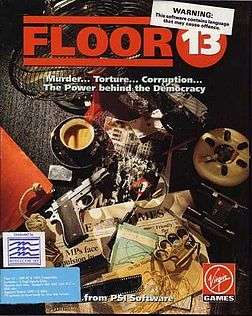Floor 13 (video game)
| Floor 13 | |
|---|---|
 | |
| Developer(s) | David J Eastman |
| Publisher(s) | Virgin Interactive |
| Platform(s) | MS-DOS, Atari ST, Amiga |
| Release date(s) | 1992 |
| Genre(s) | Strategy game |
| Mode(s) | Single player |
Floor 13 is a single-player computer game set in the United Kingdom, where the player is the director of a secret governmental agency involved in clandestine domestic operations. The headquarters is hidden on the thirteenth floor of a building in London Docklands, hence the title. The game was developed in 1991 by Virgin Interactive, a now-defunct division of the Virgin Group.
Plot
The player takes on the role of the Director General of the "Department of Agriculture and Fisheries", a non-existent Executive Agency that conceals a secret police which keeps the government popular by any means necessary. Answering only to the Prime Minister, the Director General has the power to use wiretapping, surveillance, smear tactics, disinformation, burglary, kidnapping, torture, and assassination to keep the government popular with the people.
In addition to the Director General's regular duties suppressing and removing those who threaten the status quo, there is also a subplot involving his membership in a secret society called "The Secret Masters of Thoth". These missions, which are received from a "Secret Master" wearing the vestments of an Egyptian pharaoh, involve more bizarre opposition than regular missions; these missions include protecting a fellow member from a Mafia assassination, foiling an attempt to subvert the nation by pod people in key positions, the protection of the Church of the SubGenius from a scandal, and restraining the growing power of the Illuminati, among others.
Gameplay
During the course of the game, the player must walk a metaphorical tightrope, with two possible ways to lose the game; every 21 days, the Prime Minister reviews the opinion polls and will fire the Director General, hereinafter known as DG, if his approval rating is under 50%. If the player is too severe, firing will be implemented by giving the DG "flying lessons". If he still has the lead, the DG will be given more money and employees to work with. With luck, the DG can temporarily keep his job by spying on and ignoring or discrediting suspects without using more severe and obvious methods such as "removal", "interrogation" or "heavy assault"; however, if the player is clumsy or blatant, the Prime Minister will quickly threaten and then order a flying lesson to be given to the DG. The last Director General (jokingly named after Richard Branson, the owner of the Virgin Group) suffered from a severe case of defenestration at the hands of Mr. Garcia, and the same will happen to the new DG if he gets too far out of line.
If the DG somehow manages to avoid being fired, out of a window or otherwise, then the game has two barely possible endings; if the player has successfully navigated through every scandal encountered for an entire year while keeping the approval rating above 50%, the government realizes that the player knows too much and appoints him or her Prime Minister; with a final note to "enjoy it while it lasts". The other ending involves successfully completing all seven Secret Master missions; the player is anointed the new head of the society and the face of the character is shown. The final note of this ending: "Was it worth it?"
Reception
Computer Gaming World's Charles Ardai called Floor 13 "the most unpleasant espionage game ever made", comparing it to a James Bond fan's reaction to Casino Royale ("It is simply handled poorly"). Beyond disliking the KGB or Gestapo-like "loathsome secret police activity" the game depicted, he wrote of the gameplay that "Hannah Arendt could not have conceived of more banal evil. Floor 13 turns acts of unmitigated cruelty into bloodless, arm's length bureaucratic functions ... a type and quality of gameplay that was obsolete in 1978".[1]
References
- ↑ Ardai, Charles (December 1992). "Virgin Games' Floor 13". Computer Gaming World. p. 109. Retrieved 5 July 2014.